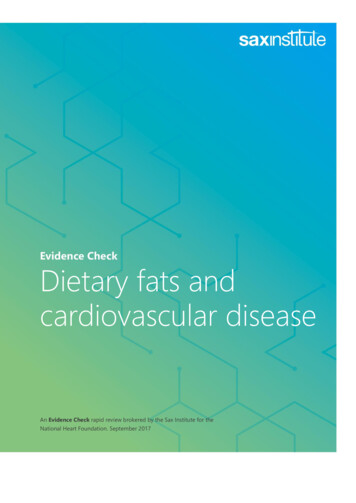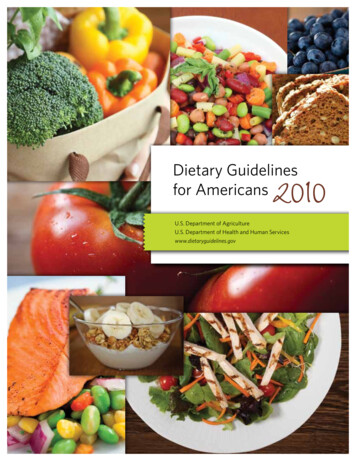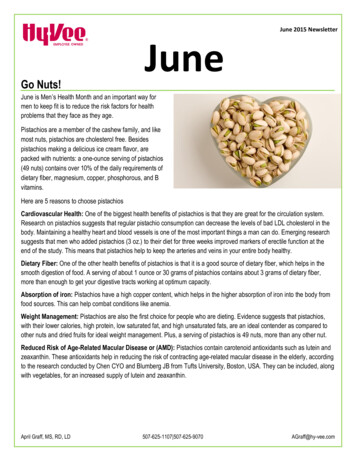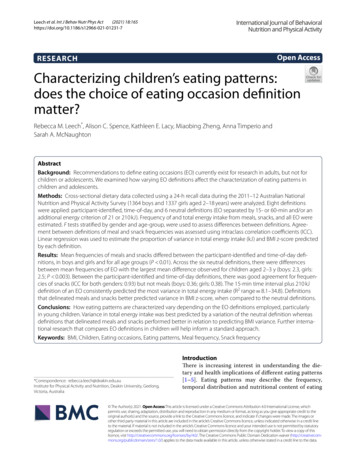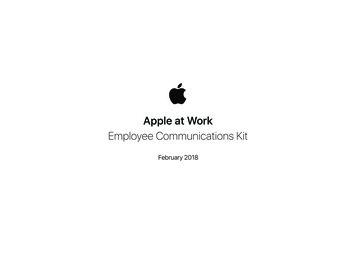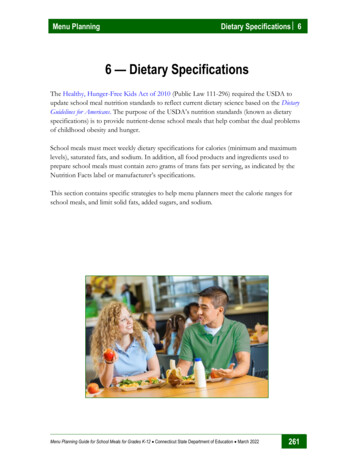
Transcription
Menu PlanningDietary Specifications 66 — Dietary SpecificationsThe Healthy, Hunger-Free Kids Act of 2010 (Public Law 111-296) required the USDA toupdate school meal nutrition standards to reflect current dietary science based on the DietaryGuidelines for Americans. The purpose of the USDA’s nutrition standards (known as dietaryspecifications) is to provide nutrient-dense school meals that help combat the dual problemsof childhood obesity and hunger.School meals must meet weekly dietary specifications for calories (minimum and maximumlevels), saturated fats, and sodium. In addition, all food products and ingredients used toprepare school meals must contain zero grams of trans fats per serving, as indicated by theNutrition Facts label or manufacturer’s specifications.This section contains specific strategies to help menu planners meet the calorie ranges forschool meals, and limit solid fats, added sugars, and sodium.Menu Planning Guide for School Meals for Grades K-12 Connecticut State Department of Education March 2022261
6 Dietary SpecificationsSMenu PlanningMenu PlanningThe daily and weekly servings of the food components required by the NSLP and SBP mealpatterns are intended to meet the calorie and nutrient needs for each grade group. However,the types of foods selected by the menu planner affect the calorie and nutrient content ofschool meals. The examples below show how different food choices within the same foodcomponent vary in nutrient content. Grains: A 1-ounce equivalent serving of 100 percentwhole-grain bread provides more fiber and nutrients, andless calories and fat than a 1-ounce serving of blueberrymuffin made with 50 percent whole-grain flour and 50percent enriched flour. Fruits: A ½-cup serving of fresh fruit salad provides fiber,more nutrients, and less calories than ½ cup of 100 percentapple juice. Vegetables: A ½-cup serving of baked potato providesmore fiber and nutrients, and less calories, fat, and sodiumthan ½ cup of oven-baked french fries. Meat/meat alternates: A 1-ounce serving of skinlessturkey breast provides less calories, fat, and sodium than a1-ounce serving of beef salami.The CSDE strongly encourages SFAs to provide the healthiest choices within each foodcomponent. Menu planners must determine how foods with solid fats and added sugars affectthe menu’s nutrient analysis and plan menus appropriately.All foods served as part of reimbursable meals count toward the weekly dietary specificationsand are included in the CSDE’s nutrient analysis of school menus, when a nutrient analysis isrequired as part of the Administrative Review of the school nutrition programs. For moreinformation, refer to “Nutrient Analysis” in section 2.262Menu Planning Guide for School Meals for Grades K-12 Connecticut State Department of Education March 2022
Menu PlanningDietary Specifications 6Resources for Dietary SpecificationsThe nutrition and menu planning resources below can assist SFAs with providing healthymeals that meet the dietary specifications. “Checking for Dietary Specifications” (in chapter 3 of USDA’s Menu Planner for er “Dietary Specifications for Grade Groups” (in chapter 2 of USDA’s Menu Planner forSchool Meals)https://www.fns.usda.gov/tn/menu-planner Child Nutrition Sharing Site (CNSS) (ICN):https://theicn.org/cnss/ Dietary Specifications (Nutrition Standards for School Meals) (“Documents/Forms”section of CSDE’s Meal Patterns for Grades K-12 in School Nutrition s#DietarySpecifications Menu Planning for Child Nutrition Programs Planning Recipes for Child Nutrition Programs (CSDE’s Menu Planning for Child NutritionPrograms Planning#Recipes Resources for the School Meal Patterns for Grades K-12 /NSLP/MealPattern/Resources School Meal Patterns gradesK-12.pdfThe USDA’s Recipes for Healthy Kids Cookbook for Schools features healthy recipes that are low insaturated fats, added sugars, and sodium; and include more dark green and orange vegetables,dry beans and peas, and whole grains. The ICN’s Child Nutrition Recipe Box website is asearchable collection of recipes and other resources for the federal nutrition assistanceprograms. Additional resources are listed below.For additional resources and guidance, refer to “Menu Planning Resources” in section 1,“Recipe Resources” in section 2, the CSDE’s Menu Planning for Child Nutrition Programswebpage, and the CSDE’s Resource List for Menu Planning and Food Production in Child NutritionProgramsMenu Planning Guide for School Meals for Grades K-12 Connecticut State Department of Education March 2022263
6 Dietary SpecificationsCaloriesSCaloriesThe dietary specifications require age-appropriate minimum and maximum calorie levels forlunches and breakfasts offered to each grade group. School meals offered on average over theweek must be within the specific calorie range for each grade group. Individual meals offeredmay be above or below the calorie range. The calorie ranges do not apply to meals selected byindividual students. Student selections may be above or below the weekly ranges.Table 6-1 summarizes the calorie ranges for the allowable grade groups of the NSLP and SBPmeal patterns.Table 6-1. Weekly calorie ranges for grades K-12 in the NSLP and SBPGrade 7009-12450-600750-850400-500600-650450-550Not applicable 2450-500Not applicable 2K-8 option16-12 optionK-12 option1211These meal pattern options are available because the calories for these grade groupsoverlap. They require a narrower calorie range and more restrictive sodium limit.These meal pattern options are not available for grades K-12 because the requiredcalorie ranges for grades 6-8 and grades 9-12 do not overlap.The CSDE’s resource, Weekly Calorie Ranges for School Meals for Grades K-12 in the NSLP andSBP, provides a summary of these requirements.264Menu Planning Guide for School Meals for Grades K-12 Connecticut State Department of Education March 2022
CaloriesDietary Specifications 6Calorie Deviations for Developmental IssuesSchools are allowed, on a case-by-case basis, to offer age-appropriate meals to individualstudents in unique situations, such as older or younger students who are placed in the gradegroup for developmental or other exceptional reasons. An example is a 16-year-old teen withdevelopmental issues who is placed with students in grades K-5. SFAs must seek writtenpermission from the CSDE prior to deviating from the required meal pattern for the prevalentgrade group.Calories for Students with Special Energy NeedsThe USDA designed the nutrition standards for school meals based on age-appropriatenutrition and physical activity habits of the average student. Meals for students with specialenergy needs (such as athletes and pregnant teens), who may require additional calories andprotein, must still meet the weekly calorie limits.Schools can provide opportunities for all students to select additional meal patterncomponents if meals do not exceed the weekly calorie limit. Students may obtain extra neededcalories from other USDA meals, such as breakfast and ASP snacks, and can also purchaseadditional a la carte foods. For more information, refer to the USDA’s resources, Fact Sheet:Athletic Programs and Afterschool Meal Service and Fact Sheet: Calories in School Meals.Meeting the Weekly Calorie RangesThe daily and weekly servings of each food component in the lunch and breakfast mealpatterns are intended to meet the minimum and maximum calories for each grade group.Depending on the types and quantities of foods offered in school meals, SFAs may need tomodify school menus to increase or decrease calories.Menu Planning Guide for School Meals for Grades K-12 Connecticut State Department of Education March 2022265
6 Dietary SpecificationsCaloriesStrategies for Increasing Calories with Complex CarbohydratesStrategies for Increasing Calorieswith Complex CarbohydratesWhen school menus do not meet the minimum weekly calories, the menu planner must adjustthe menu to increase calories to the appropriate grade-group level. Menu planners shouldfocus on adding calories from nutrient-dense foods, following the recommendations of theDietary Guidelines for Americans.Nutrient-dense foods are naturally rich in fiber and other nutrients, and contain relatively fewcalories. They provide a variety of health benefits, such as decreasing the risk of cardiovasculardisease. Examples of nutrient-dense foods include fruits, vegetables (especially the dark green,red/orange, and legumes subgroups), whole grains, low-fat or nonfat dairy products, leanmeat, skinless poultry, fish, and eggs.When school menus need additional calories, the menu planner should increaseservings of naturally nutrient-dense, fiber-rich, complex carbohydrate foods,including vegetables (especially the dark green, red/orange, and legumes subgroups),fruits, and whole grains.To increase complex carbohydrate foods in school meals, menu planners should adjust menusto: 266include whole unprocessed or minimally processed fruits and vegetables most often;increase the frequency of legumes (dry beans and peas), e.g., such as kidney beans,lentils, black beans, lentils, split peas, and garbanzo beans (chickpeas);provide additional servings of vegetables and fruits, e.g., serving three kinds of fruitsor vegetables instead of two;increase the serving size of vegetables and fruits, as appropriate to the grade groupbeing served; andincrease the frequency of whole-grains and cereals, such as whole-wheat pasta, wholegrain breads, oatmeal, bulgur, and brown rice. For information on whole grains, referto the CSDE’s resource, Crediting Whole Grains in the NSLP and SBP.Menu Planning Guide for School Meals for Grades K-12 Connecticut State Department of Education March 2022
CaloriesDietary Specifications 6Strategies for Increasing Calories with Complex CarbohydratesThe guidance below assists SFAs with adjusting school menus that are below the requiredweekly calorie ranges by increasing nutrient-dense, fiber-rich, complex carbohydrate foodsthrough menu planning, purchasing, meal preparation, and modifying recipes. The foods andingredients listed below may or may not credit in school meals. For more information, refer tothe USDA’s Food Buying Guide for Child Nutrition Programs and visit the CSDE’s Crediting Foodsin School Nutrition Programs webpage.Menu Planning Review recipes and read Nutrition Facts labels of commercial products for fiber content.Choose nutrient-dense foods that are naturally high in fiber. For more information, referto “How to Read a Food Label” in this section. Plan menus to include more 100 percent whole-grain products than WGR products. Formore information, refer to “Part B: WGR Criteria” in section 3. Add more legumes (e.g., chickpeas, lentils, and pinto beans) and whole grains (e.g., barley,bulgur, and brown rice) to menus and recipes. For example, menu planners can includemore legumes in school menus by serving legume-based dishes instead of meat, poultry,or cheese dishes at least once a week; serving more legume side dishes such as three-beansalad, split pea or lentil soup, and hummus (pureed garbanzo beans); using whole orpureed beans to replace some or all of the meat in entree recipes, e.g., chili, burritos, andtacos; and adding legumes to commercial foods, e.g., adding kidney beans to commercialMinestrone soup. To increase acceptability to students, plan nutrition education activitiesand taste tests around the new food items. For resources on legumes, refer to “Resourcesfor legumes” under “Meat/Meat Alternates” in section 3. Serve fresh fruits and vegetables instead of fruit and vegetable juices. Juice is notnutritionally equivalent to whole fruits and vegetables, and provides more calories. Serve whole or cut-up fruits and vegetables most often. Serve fresh fruits (whole or cutup) instead of canned fruits. Serve a variety of raw vegetables regularly.Menu Planning Guide for School Meals for Grades K-12 Connecticut State Department of Education March 2022267
6 Dietary SpecificationsCaloriesStrategies for Increasing Calories with Complex Carbohydrates Serve whole-grain pasta-vegetable salads made with low-fat dressings. Serve baked potatoes instead of mashed potatoes. Serve more salads and offer a variety of vegetable and fruitingredients. Serve 100 percent whole-grain RTE breakfast cereals and hot breakfast cereals (such asoatmeal or buckwheat) most often. Serve applesauce or other fruit purees (e.g., strawberries) as an alternative to maple syrupon pancakes and waffles. Serve dried fruit (such as raisins or dried apricots) or a trail mix containing dried fruits andwhole-grain low-sugar cereals. Add vegetable-based soups to the menu. Crediting note: Only certain types ofcommercial vegetable soups credit in school meals. Soups made from scratch credit basedon the amount of vegetables in the standardized recipe. For more information, refer to“Soups” in section 3. Review commercial soups for sodium content.Purchasing Request that vendors provide nutrition information for all products. Read Nutrition Factslabels and ingredients to identify products that are naturally high in fiber. For moreinformation, refer to “How to Read a Food Label” in this section. Compare brands before purchasing to determine if a comparable product is higher infiber. Purchase a variety of fresh fruits and vegetables regularly. Purchase cruciferous vegetables frequently, such as broccoli, cauliflower, cabbage, andBrussels sprouts. Purchase 100 percent whole-grain foods most often. Write food specifications to includemore 100 percent whole-grain foods, e.g., whole-grain bread products, oatmeal, quinoa,and brown rice. Make sure that the products received are the ones specified. For268Menu Planning Guide for School Meals for Grades K-12 Connecticut State Department of Education March 2022
CaloriesDietary Specifications 6Strategies for Increasing Calories with Complex Carbohydratesinformation on whole grains, refer to the CSDE’s resource, Crediting Whole Grains in theNSLP and SBP. Purchase legumes (dried beans and peas) frequently. For examples of legumes, refer to theCSDE’s resource, Vegetable Subgroups in the NSLP. Compare product information and purchase whole-grain breakfast cereals containing atleast 2.5 grams of fiber per manufacturer’s serving. At least 5 grams of fiber per serving isideal. For more information, refer to “How to Read a Food Label” in this section.Meal Preparation Add whole-grain pasta, brown rice, quinoa, and other whole grains to soups, stews, andcasseroles. Sprinkle oat bran or wheat germ over salad, soups, breakfast cereals, and yogurt.Crediting note: Bran and germ add calories and fiber to recipes but are not creditablegrains. Use crushed whole-grain unsweetened RTE breakfast cereals or rolled oats as breading forbaked fish and chicken. Serve fruits and vegetables with their skins.Modifying Recipes Add chopped dried fruits without added sugars (e.g., apricots,raisins, dates, figs, and prunes), finely chopped nuts, oatmeal, andpureed vegetables and fruits (e.g., canned pumpkin and applesauce)to baked goods such as muffins and breads. Substitute whole-wheat or other whole-grain flours for enriched white flour in recipes. Use whole-grain products (e.g., whole-grain bread, cracker crumbs, or RTE breakfastcereals) as a topping for casseroles or breading for chicken. Add rolled oats to entree recipes such as meatloaf, tacos, and meat sauce.Menu Planning Guide for School Meals for Grades K-12 Connecticut State Department of Education March 2022269
6 Dietary SpecificationsCaloriesStrategies for Increasing Calories with Complex Carbohydrates Add lentils or bulgur to hamburger dishes. Crediting note: Lentils credit as either thevegetables or meat/meat alternates component, but not both in the same meal. For moreinformation, refer to “Crediting Legumes as Vegetables” and “Crediting Legumes asMeat/Meat Alternates” in section 3. Bulgur is a whole grain and credits as the grainscomponent. Add legumes (whole, mashed, or pureed) such as kidney beans, lentils, black beans, andgarbanzo beans (chickpeas) to entrees, stews, side dishes, and salads. For example, blackbeans added to burritos and lentils added to brown rice pilaf. Crediting note: Lentilscredit as either the vegetables or meat/meat alternates component, but not both in thesame meal. For more information, refer to “Crediting Legumes as Vegetables” and“Crediting Legumes as Meat/Meat Alternates” in section 3. Add legumes such as kidney beans and black beans to commercial soups, e.g., kidneybeans added to canned minestrone soup. Crediting note: Only certain types ofcommercial vegetable soups credit in school meals. For more information, refer to“Crediting Soups” in section 3. Add pureed beans to taco mix, meat sauce, and similar entrees. They will thicken themixture and take on the flavor of the dish. Crediting note: Pureed beans credit as themeat/meat alternates component but not the vegetables component, unless the food alsocontains an adequate amount of recognizable creditable vegetables. For more information,refer to “Crediting Pureed Vegetables” in section 3. Make bread items such as French toast and garlic breadfrom 100 percent whole-grain bread. Add rolled oats to entree recipes such as meatloaf and tacos. Increase the amount of whole grains (e.g., brown rice, quinoa, and whole-grain pasta) andvegetables in stews, soups, casseroles, and similar entrees.270Menu Planning Guide for School Meals for Grades K-12 Connecticut State Department of Education March 2022
CaloriesDietary Specifications 6Strategies for Decreasing CaloriesWhen school menus exceed the weekly calorie limit, the menu planner must adjust the menuto decrease calories to the appropriate grade-group level. Focus on replacing foods that arehigher in saturated fats and added sugars with lower calorie, nutrient-dense foods; reducingthe amount of noncreditable foods; and limiting additional portions. The recommendationsbelow help decrease calories in school meals. The strategies for reducing fats also help toreduce calories. For detailed guidance, refer to “Strategies for Limiting Saturated and TransFats” in this section. Serve less juice. Juice is more calorie dense than whole fruits and vegetables. Forexample, ½ cup of grape juice contains about 80 calories while ½ cup of fresh grapescontains about 52 calories. In addition, juice does not provide the same nutritionalbenefits as whole fruits. For more information, refer to “Fruits Component” in section 3and “Weekly Juice Limits at Lunch” and “Weekly Juice Limits at Breakfast” in section 4. Serve less canned fruit. Canned fruits in juice and light syrupcontain more calories than whole fruits and canned fruits in water.Substituting whole fruits for canned fruits decreases calories andprovides more nutrients. For example, peaches in juice and lightsyrup contain about twice the amount of calories as fresh peachesand canned peaches in water (refer to table 6-1).Table 6-2. Calorie content of fresh and canned peachesSource: USDA Food Data Central, https://fdc.nal.usda.gov/Menu Planning Guide for School Meals for Grades K-12 Connecticut State Department of Education March 2022271
6 Dietary SpecificationsCalories Serve dried and frozen fruit without added sugar. Read Nutrition Facts labels andingredients to identify products that contain added sugars. For more information,refer to “How to Read a Food Label” in this section. Use low-fat dairy products in school recipes. Menu planners can decrease caloriesand saturated fats in school recipes by substituting low-fat or fat-free milk for wholeor reduced-fat (2%) milk, and substituting low-fat dairy products (e.g., low-fat cheeseand low-fat or fat-free yogurt) for full-fat dairy products. Serve whole or cut-up fruits and vegetables most often. Whole fruits andvegetables are low in calories and high in nutrients. For more information, refer to“Fruits Component” and “Vegetables Component” in section 3. Limit additional meat/meat alternates. Serve only enough of the meat/meatalternates component to meet the minimum daily and weekly requirement for eachgrade group. Additional amounts of meat/meat alternates provide more calories andmay provide more saturated fats and sodium. Other strategies to reduce calories frommeat/meat alternates include limiting or eliminating processed meats, such asluncheon meats, hot dogs, and sausage; using reduced-fat or low-fat cheese in recipesand purchasing commercial products made with reduced-fat or low-fat cheese; andwriting purchasing specifications to limit the fat content of commercial meat/meatalternate products such as pizza, chicken nuggets, and hot dogs. Limit additional grains. Serve only enough of the grains component to meet theminimum daily and weekly requirement for each grade group. Additional servings ofgrains provide more calories. Eliminate grain-based desserts. Grain-based desserts often contain more calories,solid fats, and added sugars. Examples include brownies, cookies, cakes, cupcakes,coffee cakes, pies, cinnamon rolls, doughnuts, cereal bars, granola bars, breakfast bars,sweet rolls, pastries, and toaster pastries. Crediting note: Lunch menus must limitgrain-based desserts to no more than 2 ounce equivalents per week. For moreinformation, refer to “Limit for Grain-based Desserts” in section 3. Limit the frequency and amount of noncreditable foods. Noncreditable foodstypically contain few nutrients and are higher in added sugars, saturated fats, andsodium. Examples include bacon, potato chips, pudding, gelatin, ice cream, jam, maplesyrup, butter, cream cheese, salad dressing, ketchup, mayonnaise, and mustard. Formore information, refer to “Noncreditable Foods” in section 3.For more information on the calorie maximums and tips to improve acceptance of schoolmeals, refer to the USDA’s resource, Fact Sheet: Calories in School Meals.272Menu Planning Guide for School Meals for Grades K-12 Connecticut State Department of Education March 2022
Dietary Specifications 6CaloriesStrategies for Decreasing Calories by Limiting Added SugarsLimiting Added SugarsThe Dietary Guidelines for Americans recommends limiting added sugars to less than 10 percentof daily calories. This recommendation is intended to help people achieve a healthy eatingpattern by meeting nutrient and food group needs through nutrient-dense food and beveragechoices, and staying within calorie limits. Eating patterns that include lower intake of addedsugars are associated with reduced risk of cardiovascular disease, obesity, type 2 diabetes, andsome types of cancer.Added sugars provide calories without any nutrients. The Dietary Guidelines for Americansindicates that Americans consume an average of almost 270 calories per day (more than 13percent of daily calories) from added sugars. Intakes of added sugars as a percent of caloriesare particularly high among children, adolescents, and young adults. Limiting foods withadded sugars helps school menus stay under the required weekly calorie limit for each gradegroup.Sources of Added SugarsManufacturers often add sugars to foods in processing or preparation, most commonly aswhite table sugar (sucrose) and corn sweeteners. Sweetened beverages (such as soft drinks,fruit drinks, and flavored waters) account for almost half of all added sugars in the UnitedStates. The other major source is snacks and sweets, including: grain-based desserts such as cakes,pies, cookies, brownies, doughnuts,sweet rolls, and pastries;dairy desserts such as ice cream,other frozen desserts, and puddings;candies;sugars;jams; syrups; andsweet toppings.Research shows that it is difficult for people to meet their nutrient needs while staying withincalorie limits if they consume more than 10 percent of their total daily calories from addedsugars. School meals should consist of foods that are naturally nutrient rich and low in addedMenu Planning Guide for School Meals for Grades K-12 Connecticut State Department of Education March 2022273
Dietary Specifications 6CaloriesStrategies for Decreasing Calories by Limiting Added Sugarssugars. Table 6-3 lists common sugars and sweeteners.Table 6-3. Common sugars and sweetenersAdded sugarsBrown rice syrupBrown sugarCorn sweetenerCorn syrupCorn syrup solidsDextrinDextroseFructoseFruit juice concentrateGlucoseHigh-fructose corn syrupHoneyInvert sugarLactoseMalt syrupMaltoseMolassesNonnutritive sweeteners 1Maple syrupNectars, e.g., peachnectar, pear nectarRaw sugarSorghum syrupSucroseSyrupSugar alcoholsArtificialPlant-based 2ErythritolAcesulfame potassium (Ace-K):Sweet One , Sunett , Sweet& Safe Stevia rebaudiana: Truvia PureVia , Enliten ,Sweetleaf IsomaltAdvantameLuo han guo (monk fruit):Nectresse , Monk Fruitin the Raw , PureLo ThaumatinMannitolAspartame: Nutrasweet, Equal ,Sugar Twin Neotame: Newtame Saccharin: Sweet and Low ,Sweet Twin , Sweet ‘N LowBrown , Necta Sweet Sucralose: Splenda 12LactitolMaltitolSorbitolXylitolHydrogenated starchhydrolysates, e.g.,hydrogenated glucosesyrups, maltitol syrups,and sorbitol syrupsUnless medically necessary, the CSDE does not recommend using foods that containnonnutritive sweeteners (artificial or plant-based) or sugar alcohols. Choose nutrient-dense foodsthat are naturally low in sugars. For information on the currently approved nonnutritivesweeteners, refer to “Additional Information about High-Intensity Sweeteners Permitted for Usein Food in the United States” on the FDA’s webpage.These sweeteners are often called “natural,” but this term has not been defined by the FDA anddoes not have any consistent meaning when used to describe foods or beverages.274Menu Planning Guide for School Meals for Grades K-12 Connecticut State Department of Education March 2022
Dietary Specifications 6CaloriesStrategies for Decreasing Calories by Limiting Added SugarsThe following guidance assists SFAs with meeting the weekly calorie ranges by reducing addedsugars through menu planning, purchasing, meal preparation, and modifying recipes. Thesestrategies will help menu planners reduce calories in school meals. The foods and ingredientslisted below may or may not credit in school meals. For more information, refer to theUSDA’s Food Buying Guide for Child Nutrition Programs and visit the CSDE’s Crediting Foods inSchool Nutrition Programs webpage.Menu Planning Determine the amount of added sugars in menu items. Review recipes for foods made onsite. Refer to the Nutrition Facts label for commercial products. Choose recipes and foodsthat are lowest in added sugars. Replace foods containing high levels of sugars with thosecontaining moderate levels of sugars. For more information, refer to “How to Read aFood Label” in this section. Increase the frequency of 100 percent whole-grainfoods and fresh vegetables and fruits, instead ofprocessed high-sugar foods. Serve whole fruits or unsweetened cooked fruit(such as baked apples with raisins) instead ofdesserts. Add spices like cinnamon, nutmeg, cloves,and allspice to enhance the flavor of cooked fruit. Eliminate or limit grain-based desserts such as cakes, cobblers, cookies, doughnuts, sweetrolls, toaster pastries, and coffee cake. Crediting note: Grain-based desserts cannot creditfor more than 2 ounce equivalents per week in the NSLP. For more information, refer to“Limit for Grain-based Desserts” in section 3. Eliminate or limit highly sweetened breakfast cereals. Replace with low-sugar whole-graincereals. If serving baked goods, choose foods made with less sugar and more nutritiousingredients like whole-wheat flour, oatmeal, chopped nuts, peanut butter, and fruits andvegetables, e.g., pumpkin, zucchini, cranberries, raisins, and carrots. Crediting note:Grain-based desserts cannot credit for more than 2 ounce equivalents per week in theNSLP. For more information, refer to “Limit for Grain-based Desserts” in section 3.Menu Planning Guide for School Meals for Grades K-12 Connecticut State Department of Education March 2022275
Dietary Specifications 6CaloriesStrategies for Decreasing Calories by Limiting Added Sugars Eliminate or limit servings of high-sugar noncreditable foods such as gelatin, jams, jellies,syrups, and sweet toppings.Purchasing Purchase foods that are low in added sugars. Request that vendors provide nutritioninformation for all products. Refer to the Nutrition Facts label to determine the amountof added sugars in commercial products. Compare brands before purchasing to determineif a comparable product is lower in added sugars. For more information, refer to “How toRead a Food Label” in this section. Write food specifications to include food items without added sugars. Examples includecanned fruit packed in natural juices or water instead of syrup, frozen fruit without addedsugar, dried fruit without added sugar, and whole-grain breakfast cereals that areunsweetened or low in added sugars. Make sure the products received are the onesspecified. Compare nutrition information for condiments such as salad dressings and barbecuesauce. Some condiments are high in added sugars. Purchase vanilla or lemon yogurt as an alternative to higher-sugar fruit flavors, or mix halfplain yogurt and half fruited yogurt. Eliminate or limit purchases of foods that are high in added sugars, such as certain snackfoods and commercial convenience foods.Meal Preparation Do not add sugars or sweeteners to recipes when they are not listed as an ingredient. Compare recipes and use those that are lowest in sugars and sweeteners.276Menu Plannin
the types of foods selected by the menu planner affect the calorie and nutrient content of school meals. The examples below show how different food choices within the same food component vary in nutrient content. Grains: A 1-ounce equivalent serving of 100 percent whole-grain bread provides more fiber and nutrients, and
